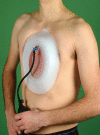Non-surgical treatment of pectus excavatum
- PMID: 29078491
- PMCID: PMC5638434
- DOI: 10.21037/jovs.2016.03.14
Non-surgical treatment of pectus excavatum
Abstract
Background: Previously used procedures to correct pectus excavatum (PE) were largely based on surgical techniques like Ravitch procedure or the minimally invasive Nuss technique. Conservative treatment with the vacuum bell (VB) to elevate the funnel in patients with PE, represents a potential alternative to surgery in selected patients.
Methods: A suction cup is used to create a vacuum at the anterior chest wall. Three different sizes as well as a model fitted for young women of VB exist which are selected according to the individual patients age. A patient-activated hand pump is used to create a vacuum at the anterior chest wall. When creating the vacuum, the lift of the sternum is obvious and remains for a different time period. The device should be used for a minimum of 30 minutes (2/day), and may be used up to a maximum of several hours daily. We have an IRB approval for it. Since this paper was conducted as a retrospective study, we did not have to have informed consent of every patient.
Results: CT-scans showed that the device lifted the sternum and ribs immediately. In addition, this was confirmed thoracoscopically during the MIRPE procedure. Preliminary results published within the last 10 years proved to be successful.
Conclusions: The VB has been established as an alternative therapeutic option in selected patients suffering from PE. The initial results proved to be dramatic, but long-term results comprising more than 15 years are so far lacking, and further evaluation and follow-up studies are necessary.
Keywords: Pectus excavatum (PE); conservative treatment; vacuum bell (VB).
Conflict of interest statement
Conflicts of Interest: The authors have no conflicts of interest to declare.
Figures










References
LinkOut - more resources
Full Text Sources
Other Literature Sources
Medical
